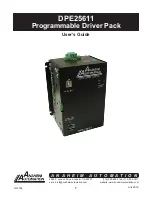
August 2012
L010796
14
Encoder Commands:
The DPE25611 controller is capable of using a quadrature incremental encoder
with A and B channels.
Encoder Auto Correct:
This command will enable or disable the encoder feature of the DPE25611.
When enabled, the encoder function will compare the desired position with the actual encoder position.
If it is not in the correct position a correction move will be made.
Encoder Delay:
This sets the wait time, which is a specified number of milliseconds after a relative
index or absolute move is finished, prior to reading the encoder. This is used to remove the ringing that
might be associated with the mechanics of the system. (Range: 0 to 65535)
Encoder Motor Ratio:
This represents the ratio for the number of encoder pulses to one motor step.
This ratio must be a whole number. For example, given a 1000 line quadrature encoder and a 400 step/
revolution motor, the motor ratio is (1000 * 4)/400 = 10 (Range: 1 to 255 and must be a whole number).
Encoder Retries:
This is the number of times the DPE25611 will try to auto correct the motor shaft
position before producing an error. When the error is produce, Output 8 is triggered. (Range: 0 to 255)
Encoder Window:
This is the allowable error in encoder pulses (either plus or minus) from the desired
position that is allowed before the motor auto corrects. (Range: 0 to 255)
Thumbwheel Index:
This special function allows a thumbwheel with up to 7 decades to be used with
the DPE25611 to set a relative index. To use the thumbwheel, SW2 must be in the TWS position or
the thumbwheel will be disabled.
Acceleration/Deceleration:
The acceleration and deceleration are the same value. The acceleration
is entered directly as steps/sec
2
and controls the time that the motor will take to move from base speed
to max speed, and from max speed to base speed. The higher the value, the faster the motor will ac-
celerate. The same principal applies for the deceleration which is controlling the time it takes to go from
the max speed to base speed. (Range: 100 to 9,999,999)
Base Speed:
The base speed is the speed at which motion starts and stops. It is entered directly as
the number of steps per second. This speed must always be less than the max speed and jog speed.
(Range: 1 to 5000)
Max Speed:
The max speed is the top speed the user wants the motor to run. This speed must always
be greater than the base speed. It is entered directly as the number of steps per second. (Range: 1
to 50000)
Jog Speed:
The jog speed sets the fast jog rate. Jog (+/-) is used to run at base speed. The FJOG
pin when grounded, will ramp the motor to the set jog speed. This speed must always be greater than
the base speed. It is entered directly as the number of steps per second. (Range: 1 to 50000)
Motor Current:
This command will control the ON/OFF output which is designed to connect to the ON/
OFF input of Anaheim Automation’s step motor drivers. To energize and allow current to flow through
the coil of the motor, set the value to on. To de-energize and turn the current off to the motor, set the
value to off. This is dedicated output and not controlled with the output register.
Verify:
The verify command causes the DPE25611 controller to send data back to the PC or PLC. The
data is sent as an ASCII decimal string followed by a carriage return and a line feed. The verify com-
mands are shown in the table on page 34.
July 2018





























